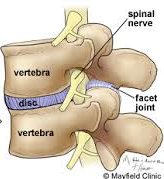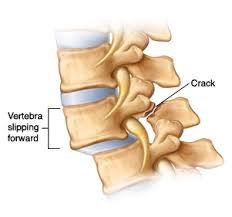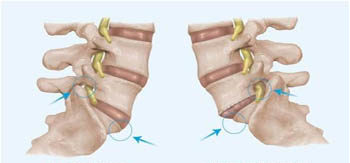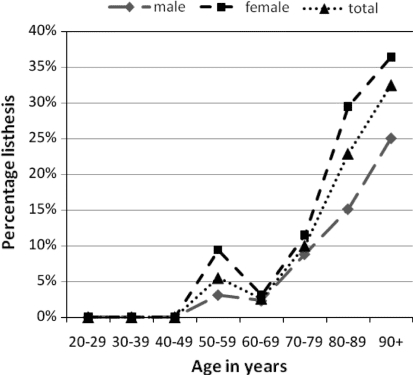As the Adult Scoliosis Spine Ages, The Spine and Its Supporting Ligaments Begin to Degenerate, Your Vertebrae begin to Shift to the Side… This is Called a Lateral Listhesis. Should you be Concerned About the Likelihood of Postural Collapse?
Degenerative or de novo scoliosis is the Adult Scoliosis that is a sideways distortion of the lower or lumbar spine combined with the arthritic changes that come with age. It typically develops after age 50. Patients usually present at our center with their scoliosis combined with loss of lordosis (normal curve of the low back seen from the side), AND often have a shifting of the vertebrae due to degeneration of their spinal joints. Although the underlying cause is not fully understood, degenerative scoliosis is associated with degenerative disk disease, failure of the small joints at the back of the spine, and a thickening of the major ligaments that are attempting to support the weakened spinal bones. This type of curvature with degeneration will often lead to nerve pain radiating down the legs and strong lower back pain and can eventually lead to a dangerous condition called postural collapse. Early treatment with a scoliosis specific exercise program and possibly adult scoliosis bracing is the best approach. Surgery can be considered in more severe cases, but the benefits and risks to the patient must be carefully considered before that choice is made.
Let’s look more closely at the underlying structures and changes that lead to this problem.
Spinal joint instability
Spinal joint instability is abnormal excessive movement (or “hypermobility”) between two vertebrae (bones of the spine). Between the vertebrae are intervertebral discs and stabilizing ligaments. The discs and ligaments hold the vertebrae together, forming stable strong joints that allow slight movement between the vertebrae with the disc also functioning as a shock absorber. As all people age the spine will experience decreased back support due to degenerative changes to the spine. Greater force is placed on the discs which then accelerates this degenerative disc disease. When a disc narrows from degeneration, the bones above and below the disc can move or slip on each other causing the vertebra to shift either forward, backward or most importantly for adult scoliosis patients, the vertebrae can slip to the side severely weakening the spine. This movement indicates segmental spinal instability. When a disc degenerates it loses tension this can cause the disc to bulge, increase movement between the vertebrae, and decrease the disc height causing the joints at the back of the spine to move out of alignment. The breakdown of structural spinal elements like discs, supportive ligaments, facet joints, and joint lubricating capsules responsible for stability leads to uni- or multi-segmental, multi-directional instability. Depending on the direction and location, this misalignment can be diagnosed as spondylolisthesis (forward slippage), lateral listhesis (side slippage) or retrolisthesis (backward slippage).
Spondylolisthesis (forward slippage)
Spondylolisthesis (also called an anterolysthesis, translational or rotary olisthesis), is an anterior (forward) slip of lumbar vertebrae (most often the fifth lumbar vertebra) and sometimes cervical vertebrae. About 5 to 7% of all people (with or without scoliosis) are affected by spondylolisthesis. The two main causes are from either a stress fracture in the vertebra called spondylolysis or by degeneration of the facet joints. It is often caused or aggravated by certain sports (repeated trauma) or it can be caused by an isolated incident (accident or fall.).
When spondylolisthesis occurs with scoliosis, is is sometimes referred to as “olisthesis“.
Retrolisthesis
Posterior (backward) slip of lumbar vertebrae.
Lateral listhesis
Lateral listhesis or rotatory subluxation is when one vertebra slides off another vertebra in both the coronal (front to back) and axial planes (top to bottom). Due to the effects of gravity, certain severe cases of scoliosis can degenerate and become lateral listhesis.
Thoracolumbar curves have the greatest propensity for developing lateral listhesis during adulthood. Back pain may be more pronounced in severe thoracolumbar curves. [1]
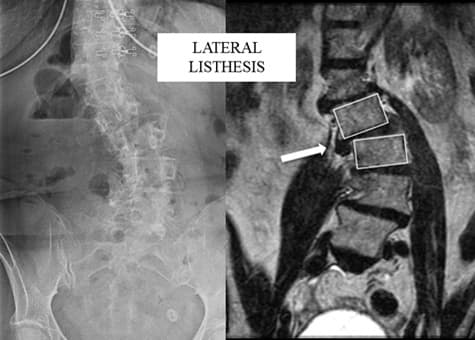
Just how common is this type of vertebral slippage? Who is prone to this destabilizing spinal complication of adult scoliosis?
Researchers in 2011 found that scoliosis with sideways slippage of the vertebrae was significantly more prevalent in women. They found that this problem typically only starts to occur after the age of 50 but will steadily increase with age. By the the time the patients in the study were over 80 years old nearly a quarter of them had the slippage.
“As the adult lumbar spine ages, the prevalence of lateral listhesis and degenerative scoliosis increases.”
“In patients with a scoliosis 44.0% had a listhesis and in patients with no scoliosis just 3.8% had listhesis.” [2]
When we see a worsening of adult scoliosis, intervention with scoliosis specific exercises is an effective treatment, not just to get stability, but to recover some degree of any postural collapse. This improvement of the scoliosis does not indicate a reduction of the degenerative changes, but instead indicates improvement of the upright posture which had begun to collapse. This reduction can decrease the chronic postural imbalance on the spine and, in the long run, reduce the risks of progression.
Degenerative Spondylolisthesis
Degenerative Spondylolisthesis occurs when a preexisting forward misalignment causes the upper vertebra to slide forward on the subjacent vertebra and the tendons, muscles and the ligaments yield under the pressure, leading to ligament instability. Degenerative Spondylolisthesis is not always associated with spondylolysis.
The degree of spondylolisthesis is measured according to the Taillard index:
- Grade 0 : No slipping
- Grade I : Minimal slipping of less than 1/3 of the vertebral plateau
- Grade II : Slipping of 1/3 to 2/3 of the trapezoidal dysplasia plateau, S-shaped sacral dome dysplasia of the posterior arch
- Grade III : Slipping of more than 2/3 of the vertebral body plateau in trapeze; domed plateau.
- Grade IV : Spondyloptosis: a complete slip, past the anterior edge of the subjacent vertebra. This condition is often associated with spinal cord compression (horsetail syndrome or central stenosis).
Let’s look at some more research into the risk of degenerative slippage in the spine.
Risk of Progression (small curves)
In one study, VERY SMALL CURVES were studied. Even in this group of very small curves (only an average of 14 degrees at the beginning of the study), curve progression was found in de novo degenerative scoliotic curves.
“46% percent of patients had lateral listhesis of more than 5 mm at L3 and L4. Curve progression was not linear and might occur rapidly, particularly in women older than 69 with lateral listhesis of more than 5 mm and levoscoliosis.” [3]
Loss of Height and Slippage of the Vertebrae
“Average shrinkage in scoliotic women was twice that in the non-scoliotic women, had begun early in adulthood, was due to the combined effect of age and scoliosis, and was strongly associated with rotatory olisthesis. In the 17 women with radiograph follow-up, curve progression was closely related to shrinkage.” [4]
Surgery vs Conservative Treatment
One study found a significantly higher rate of spinal stenosis and degenerative spondylolisthesis in patients who underwent surgery (decompression and spondylodesis). [5]
